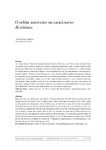O refrán intercalar no cancioneiro dionisíaco

Ver/
Use este enlace para citar
http://hdl.handle.net/2183/13236Coleccións
Metadatos
Mostrar o rexistro completo do ítemTítulo
O refrán intercalar no cancioneiro dionisíacoAutor(es)
Data
2012Cita bibliográfica
Novas achegas ao estudo da cultura galega II. Enfoques socio-históricos e lingüístico-literarios; 2012: 279-289. ISBN: 978-84-9749-517-2
Resumo
[Resumo] Este artigo pretende abordar o fenómeno trobadoresco do refrán intercalar. Deste modo, achegarémonos brevemente aos primeiros, aínda que exiguos, testemuños provenzais, para, a seguir, centrar a nosa atención na análise das tres cantigas de amor do rei Don Denís en que se desenvolve o citado fenómeno. Tamén faremos referencia a algunha outra composición do rei que consideremos relevante para o presente traballo. Debemos ter en conta que, no corpus da lírica medieval galego-portuguesa, o número de composicións que presentan refrán intercalar supera escasamente o medio centenar, razón por que consideramos destacábel o amplo uso que Don Denís fai deste recurso, xa que o inclúe en trece das súas poesías. Neste sentido, o feito de o rei-trobador recorrer ao refrán intercalar nun número tan elevado de cantigas podería ser o indicio definitivo que probase a responsabilidade do seu pai, Afonso III ‘O Bolonhês’, na introdución deste artificio na lírica galego-portuguesa [Abstract] This paper aims at studying the interpolated refrain phenomenon. We will briefly approach the first, though exiguous, Provençal texts, in order to focus, then, on the three love poems by D. Dinis, where the aforementioned phenomenon occurs. Furthermore, we will refer to some of the other compositions of the Portuguese king, that we consider relevant for this case study. It must be taken into account that the number of compositions that show an interpolated refrain in the Galician-Portuguese medieval lyric corpus hardly exceeds fifty poems. This is why we consider the great use D. Dinis makes of this rhetorical device, that appears in thirteen poems of his authorship, to be outstanding. In this sense, the fact that the troubadour king uses interpolated refrains in such a high number of compositions could be seen as the definitive evidence of Afonso III, ‘O Bolonhês’ responsibility in the introduction of this rhetorical device in Galician-Portuguese lyric.
Palabras chave
Refrán intercalar
D. Dinis
Afonso III
Lírica medieval galego-portuguesa
Lírica provenzal
Interpolated refrain
Galician-Portuguese lyric
Provençal lyric
D. Dinis
Afonso III
Lírica medieval galego-portuguesa
Lírica provenzal
Interpolated refrain
Galician-Portuguese lyric
Provençal lyric
ISBN
978-84-9749-517-2





